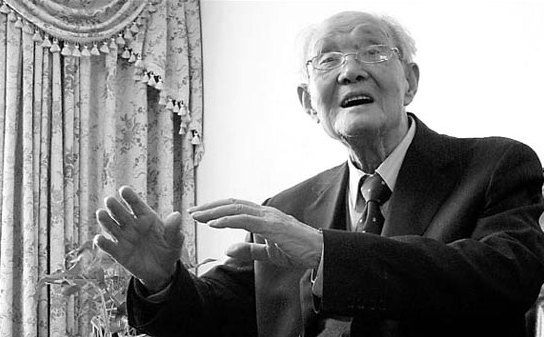Father of Chinese stenography dies
Updated: 2012-12-20 07:53
By Xu Lin (China Daily)
|
||||||||
|
Tang Yawei has made great contributions to Chinese stenography in his lifetime. Zou Xian / China News Service |
For decades, Tang Yawei's name has been considered synonymous with stenography in China.
"Stenographers are history recorders. My biggest wish is to make shorthand a booming industry in China," he said in an earlier interview with China Daily.
The leading authority in the industry that created the era of new shorthand in China passed away this week. Tang died at the age of 97 on Tuesday afternoon in a hospital in Beijing.
He had made a great contribution to Chinese stenography in his lifetime, and founded the ubiquitous Yawei Steno Schools and popular Yawei shorthand method.
In 2004, he was awarded the Lifetime Achievement Award by the International Federation for Information Processing, the only Chinese to have won the honor.
One of his most remarkable inventions is the Yawei Chinese steno machine, with an average speed of more than 200 words per minute, while the speed of pen stenography is only about 120 words.
It is widely used in courts, government departments, diplomatic occasions, conferences and business negotiations.
Tang's passion for shorthand never faded. He even asked his son Tang Kewei, to follow his footsteps.
Tang Kewei later established a company to promote his father's ideas and steno machines.
"My father only did one thing in his life - shorthand. He never forgets it, even when he's ill," Tang Kewei says.
"He's widely respected in the steno circle due to his deep knowledge and open-minded character. He didn't care for wealth or fame and likes to do research. He's a strict father, too," he recalls.
The son says it's very meaningful to inherit his father's steno industry, and he's put all his efforts in it for 30 years. After his father's death, he received many messages of condolences from students and shorthand associations.
Tang Yawei started exploring the possibility of a shorthand machine as early as the "cultural revolution" (1966-76), and he invented a set of symbols based on the keyboard of English typewriter at that time. It failed due to its complicated rules and noise.
"Pen stenography is convenient as one can take notes as long as one has pen and paper. But it is tedious to translate these symbols into words. It may take six hours to translate an hour's steno note," he said.
In the 1990s, inspired by a piano performance, Tang designed an exclusive keyboard that allows stenographers to press the keys with both hands at the same time, one for initial consonants and another for compound vowels.
The new steno keyboard saves a lot of time compared with traditional typing.
He believed shorthand could be greatly developed if a computer could do the boring translation work instead. Tang, in his 70s, redesigned a 24-key shorthand keyboard and steno-coding scheme for the computer in 1993 after many experiments and failures.
One year later, Yawei Steno Machine made its debut at the National Computer Exhibition, attracting wide attention, and many Chinese courts started to use it in 1996.
He became interested in stenography by accident in 1930, when he was attracted to Gregg Shorthand in a second-hand bookstore. The book introduced English stenography that gained popularity in the US in the early 20th century. As he found the subject very useful, he started to read related books.
Later while he was studying in a mission school and served as secretary to the headmaster, he developed the popular Yawei shorthand method through his daily work of recording documents and letters.
After the outbreak of the War of Resistance Against Japanese Aggression in 1937, Tang escaped to Chongqing and taught shorthand as a means of livelihood for many jobless youth.
Financially supported by his mother and friends, he published the book Standard Yawei Chinese Shorthand and offered stenography training.
Later, he founded Yawei Steno School and met with the patriotic warlord Feng Yuxiang, who greatly supported his work and held the post of board chairman of the school.
When the war ended in 1945, he followed Feng to Shanghai the next year and moved the school there.
Some of his students played important roles in the war. For example, one was spying for the Communist Party and gathering important military intelligence.
"I was shocked as well as sad when I heard about the news. Tang made a great contribution to Chinese stenography," says Lian Zhengbao, former chief archivist of the Bureau of Archives, Ministry of Foreign Affairs.
Lian says he used the Yawei shorthand method at diplomatic occasions with Chinese leaders, including Mao Zedong and Zhou Enlai, from late 1960s to the 1980s.
"It's both quick and accurate," he says.
xulin@chinadaily.com.cn
(China Daily 12/20/2012 page20)

 Relief reaches isolated village
Relief reaches isolated village
 Rainfall poses new threats to quake-hit region
Rainfall poses new threats to quake-hit region
 Funerals begin for Boston bombing victims
Funerals begin for Boston bombing victims
 Quake takeaway from China's Air Force
Quake takeaway from China's Air Force
 Obama celebrates young inventors at science fair
Obama celebrates young inventors at science fair
 Earth Day marked around the world
Earth Day marked around the world
 Volunteer team helping students find sense of normalcy
Volunteer team helping students find sense of normalcy
 Ethnic groups quick to join rescue efforts
Ethnic groups quick to join rescue efforts
Most Viewed
Editor's Picks

|

|

|

|

|

|
Today's Top News
Health new priority for quake zone
Xi meets US top military officer
Japan's boats driven out of Diaoyu
China mulls online shopping legislation
Bird flu death toll rises to 22
Putin appoints new ambassador to China
Japanese ships blocked from Diaoyu Islands
Inspired by Guan, more Chinese pick up golf
US Weekly

|

|







